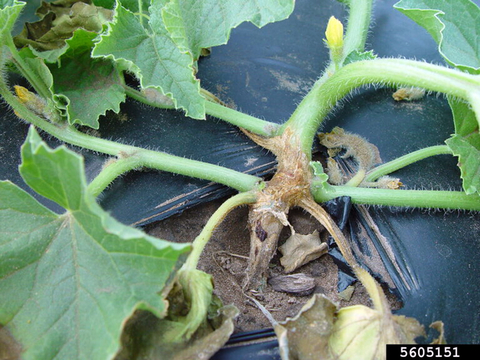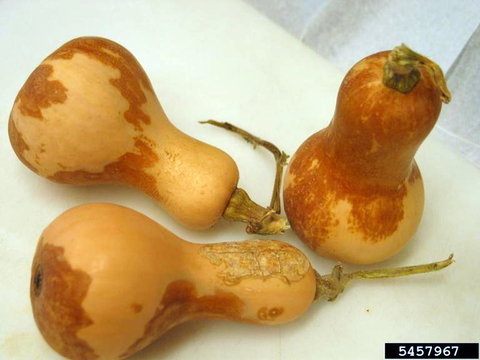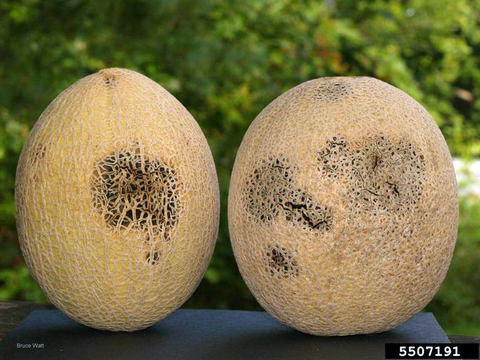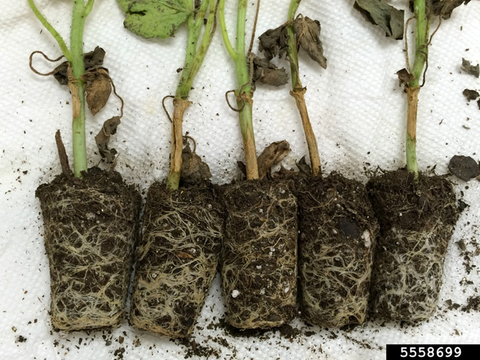Quick facts
- Gummy stem blight describes the leaf and stem infection stages of the disease. Black rot describes the fruit rot stage. Both are caused by the fungus Didymella bryoniae.
- Leaf symptoms start as browning at leaf edges.
- Fruit rot initially looks water-soaked. It later turns completely black.
- The fungus survives from season to season in crop debris.
- Moisture on the leaves and high humidity make plants more susceptible to this disease. Use drip irrigation instead of overhead sprinklers if possible.
- Rotate vegetables so two or more years pass before planting any member of the squash family in the same location.
How to tell gummy stem blight and black rot from other cucurbit issues
- Leaf symptoms start as browning at leaf edges.
- In pumpkin, cucumber and summer squash, leaf infections develop into a brown wedge extending into the leaf tissue.
- In melon, browning develops into brown discoloration between veins or into circular tan to brown spots.
- Winter squash do not develop leaf or stem blight but may be vulnerable to black rot.
- Yellow halos may occur around leaf spots and older spots are often dry and cracked.
- Tan lesions develop on infected stems, often close to the crown of the plant. These lesions crack open and exude gummy, amber-colored fluid.
- Black, raised, spore-producing structures and dark gummy substances are common within stem infections.
- Fruit rot initially looks water-soaked. Later it turns completely black.
- Raised, black, pimple-like spore-producing structures are common in the black areas of fruit infections.
- Fruit infections may develop in the field or in storage depending on the crop.
Biology
- The fungus Didymella bryoniae enters through wounds.
- Plants infested with cucumber beetles, aphids and powdery mildew have higher rates of black rot and gummy stem blight than pest-free plants due to minor wounding caused by these pests.
- Infected seed can bring the black rot fungus into the field.
- The fungus survives from season to season in crop debris.
- New spores (reproductive structures) form in spring in response to wet weather.
- Spores easily spread throughout the field on splashing water.
- Moisture on the leaves and high humidity can increase the likelihood of disease.
Managing gummy stem blight and black rot in the home garden
- There are gummy stem blight and black rot resistant varieties of watermelon, pumpkin, buttercup, and canary melons available. See the Cornell Disease Resistant Vegetable Variety page for more information.
- Buy clean seed from a reputable source. If saving seed, do not collect seed from infected plants.
- Rotate vegetables so two or more years pass before planting any member of the squash family in the same location.
- Use drip irrigation instead of overhead sprinklers if possible. If you’re watering by hand, water at the base of the stem.
- Remove and destroy infected fruit and vines at the end of the season in small gardens.
- Use integrated pest management practices to control cucumber beetles and other insect pests
Managing gummy stem blight and black rot on farms
|
- There are gummy stem blight and black rot resistant varieties of watermelon, pumpkin, buttercup, and canary melons available.
- See the Cornell Disease Resistant Vegetable Variety page for more information.
- Buy clean seed from a reputable source. If saving seed, do not collect seed from infected plants.
- Rotate vegetables so two or more years pass before planting any member of the squash family in the same location.
- Use drip irrigation instead of overhead sprinklers if possible.
- Remove and destroy infected fruit and vines at the end of the season in small plots.
- In large fields, till in infected plant debris at the end of the season to speed up decomposition.
- Use integrated pest management practices to control cucumber beetles and other insect pests, as well as powdery mildew.
- Commercial growers should refer to the Midwest Vegetable Production Guide for specific fungicide recommendations.
CAUTION: Mention of a pesticide or use of a pesticide label is for educational purposes only. Always follow the pesticide label directions attached to the pesticide container you are using. Be sure that the plant you wish to treat is listed on the label of the pesticide you intend to use. And observe the number of days between pesticide application and when you can harvest your crop. Remember, the label is the law.
Reviewed in 2022






